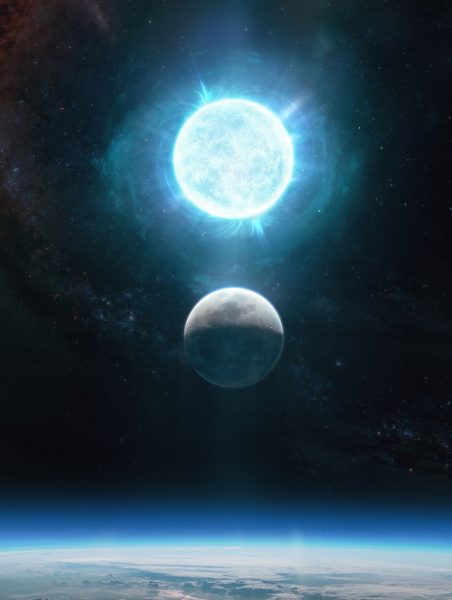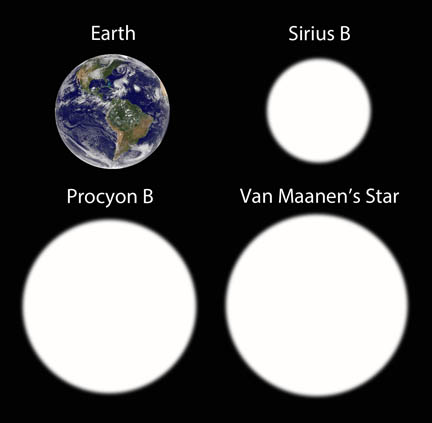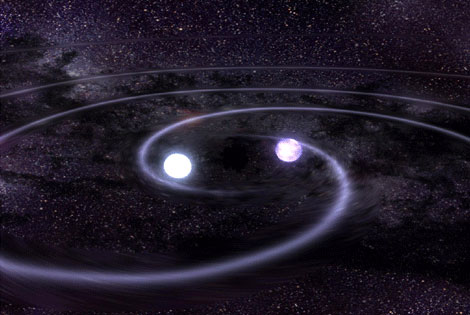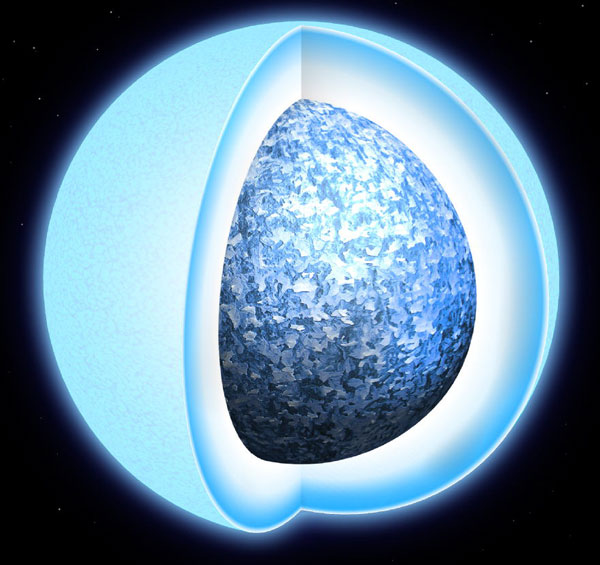Astronomers have discovered a white dwarf only slightly bigger than the Moon, making it the smallest ever found. It might even be on the edge of collapse.

Giuseppe Parisi
Not far from us is a faint, hot cinder of a star, a white dwarf still smoldering from its formation less than 100 million years ago. Most such objects are the collapsed cores of low-mass stars. But this one is different.
In the July 1st Nature, Ilaria Caiazzo, Kevin Burdge (both at Caltech), and their colleagues report evidence that this white dwarf was born out of the union of two punier siblings. As a result, it’s the smallest white dwarf known — and just this side of collapse.
Small Yet Massive
White dwarfs owe their existence to quantum mechanics. While stars fuse elements to release thermal pressure and counteract gravity, white dwarfs can’t muster the conditions for fusion. Instead, gravity compacts their cores until electrons are forced practically next to each other. But according to the Pauli Exclusion Principle, electrons won’t stand for that — they physically cannot share the same energy state. So electrons that don’t fit in the lowest energy levels, where they’d prefer to be, instead go to higher and higher levels, whizzing around the core at greater and greater speeds.
These fluttering electrons provide their own kind of pressure that supports the core against gravitational collapse. The result is counterintuitive: The more mass a white dwarf has, the smaller it becomes in order to generate the necessary pressure to stave off collapse.

Bob King
That works until there’s too much mass, and the fastest electrons are forced to flit about at near the speed of light, at which point they can’t generate enough pressure to forestall destruction. When a pair of white dwarfs merges, the scale often tips over the Chandrasekhar limit, beyond which runaway nuclear reaction ensues and the stellar cinder detonates.
But if the white dwarf parents are runts, their child might not tip that scale. That’s what Caiazzo thinks her team has found: a white dwarf born out of a white dwarf-white dwarf union that’s just this side of the Chandrasekhar limit that would mean its collapse or destruction.
Burdge found the object in data collected by the Zwicky Transient Facility in California. A megapixel camera at the Palomar Observatory scans the entire night sky every other night. Using a special computer algorithm to sort through frames taken 48 hours apart, Burdge was able to search for things varying on minutes-long timescales.
“There aren’t that many things that brighten or fade over minutes,” Burdge says. “Pretty much anything that does that is interesting.” And among the interesting finds was the white dwarf, which follow-up observations confirmed was rotating every 7 minutes. (The record-holder, EPIC 228939929, spins every 5.3 minutes.)

NASA / Dana Berry, Sky Works Digital
The rotation was the first hint that something about this one was different. Most white dwarfs rotate over hours, not minutes. But any white dwarf that’s the product of a merger would spin more quickly. And a fast spin should produce an extreme magnetic field. Indeed, Caiazzo and her colleagues obtained spectroscopy using the W. M. Keck I Telescope on Mauna Kea, Hawai‘i, that showed the white dwarf’s magnetic field is on the extreme end — a billion times stronger than Earth’s.
Most intriguingly, though, Caiazzo and her colleagues found the white dwarf was exceedingly small, just slightly bigger than the Moon at 4,300 kilometers (2,700 miles) across. And because more massive white dwarfs are more compact, the small size suggests this is also the most massive white dwarf known. While the exact mass depends on what the white dwarf is made of, the researchers estimate it’s about a third more massive than the Sun: between 1.327 and 1.365 solar masses, depending on its composition.
(The white dwarf in the T Coronae Borealis system was measured to be even more massive at 1.37 solar masses, but hot gas streaming off its stellar companion and other complicating factors make that measurement more uncertain, Burdge says.)
However, because the white dwarf’s composition and mass are not exactly known, a question remains. Is the white dwarf so small simply because it’s so massive? Or is it actually in the process of collapsing?
Close to Collapse?
The answer depends on exactly where the Chandrasekhar limit lies. That limit is approximately 1.37 solar masses, but the exact definition actually depends on what the white dwarf is made of. And, if a white dwarf is near collapse, then the composition — and therefore the limit — is changing.
What’s more, the nuclei of a white dwarf’s heaviest elements can capture electrons, depriving the white dwarf of their outward pressure and thus speeding gravitational collapse. And while the heaviest elements are initially spread out, like sediment that drifts to the bottom of a wine glass, they settle into the white dwarf’s core over a few hundred million years and speed up electron capture.
However, this process competes against the crystallization of the white dwarf’s core as it cools. The same heavy atoms that can capture electrons can also engage in reactions that produce neutrinos. These ghostlike particles easily escape the white dwarf’s gravity, carrying energy away with them. If a white dwarf cools enough, its core solidifies, freezing into a lattice that is stable against collapse.
Caiazzo and her team estimate that this particular object could crystallize anywhere between 10 or 100 million years from now — a rough estimate because the cooling process isn’t yet well understood in massive white dwarfs. (Less massive white dwarfs can take billions of years to cool down into crystals.)

University of Warwick / Mark Garlick
Even if it did collapse, it’s still unclear if it would explode as a Type Ia supernova, the fate it has so far avoided, or if it would instead implode to form a neutron star.
“It’s not happening tomorrow,” Caiazzo notes. Collapse could take on the order of 100 million years.
Intriguingly, though, the object is so nearby (134 light-years) that it’s probably not rare. Indeed, one other fast-spinning, highly magnetic (though not quite as small) white dwarf has previously been found. As facilities such as the under-construction Vera Rubin Observatory reach deeper for their time-lapse movies of the night sky, astronomers may well discover many more white dwarfs with such unusual births.
 16
16









Comments
Rod
June 30, 2021 at 12:09 pm
Good report. I checked the Nature link and the radius reported in the abstract about 2140 km. A white dwarf with 1.44 solar mass and this radius, mean density ~ 7 x 10^7 g cm^-3. Interesting report here.
You must be logged in to post a comment.
Robert-McCabe
June 30, 2021 at 3:44 pm
2140 km would make it smaller than the moon!
You must be logged in to post a comment.
Cousin Ricky
June 30, 2021 at 7:46 pm
The Moon’s radius is 1737 km. Are you confusing it with the diameter?
You must be logged in to post a comment.
Cousin Ricky
June 30, 2021 at 7:49 pm
How does one measure the dimensions of a white dwarf? We don’t have interferometers that sensitive, do we?
You must be logged in to post a comment.
Monica YoungPost Author
July 2, 2021 at 1:35 pm
Good question - no, astronomers can't use interferometry to get the size of the star, it's a bit more indirect. They first measured the photometry (the white dwarf's brightness in different wavelength bands) and then adjusted a white dwarf model until it produced the same brightness in those bands. The information from the model was then combined with an extremely precise measurement of the white dwarf's distance (from Gaia parallax) to get the radius.
You must be logged in to post a comment.
tonyzito
July 2, 2021 at 5:38 pm
So how good is that, do you think?
You must be logged in to post a comment.
Monica YoungPost Author
July 3, 2021 at 9:12 am
The radius, because it's based on the parallax, is quite a precise measurement: 2,140 km, with a possible range of values from 1,910 km to 2,300 km.
You must be logged in to post a comment.
Andrew James
June 30, 2021 at 8:38 pm
"Not far from us is a faint, hot cinder of a star, a white dwarf still smoldering from its formation." Smoldering infers burning with smoke. Incandescent or candescent might be more appropriate.
Chandrasekhar limit for solitary white dwarfs is fixed at 1.44 solar masses or 2.77×10^30 kg., but is slightly lower in very special circumstances (like mergers), estimated as low as 1.37 solar masses.
Also the statement: "And, if a white dwarf is near collapse and elements are starting to fuse in its core, then the composition — and therefore the limit — is changing." is a little oddly expressed because fusion has ended by the WD stage. Inside solitary WD occurs diffusion, where heavy elements sink lighter elements rise - creating a dense surface hydrogen atmosphere - hence novae. The size of the WD changes in size as it cools - just like the dramatic change by placing an air filled balloon in liquid nitrogen. However, in more simplistic terms, for WD discussed here, the merging causes dramatic intermixing and reorganisation of the WD interior that prevents the neutron star or SN Type I occurring. As it cools, diffusion slowly increases the interior's density increasing the collapse, and so the catastrophe may occur later sometime in the future.
Also the smaller size could be caused by the hydrogen atmosphere being stripped away by the final stages of the binary WD interactions. When merged, the white dwarf stars would have more heavier elements and make this WD appear smaller than a solitary WD?
You must be logged in to post a comment.
Monica YoungPost Author
July 2, 2021 at 1:46 pm
Actually, according to the American Heritage Dictionary, smoldering (the verb or adjective) implies burning with "little smoke and no flame." It can also suggest a suppressed kind of burning, like "revolution smoldering in the masses." The white dwarf, despite being so hot, is small and so quite faint despite being so near, so I used the word "smoldering" to evoke that overall sense (even though, as you point out, it's not actually burning).
If the white dwarf began collapsing, then there would actually be some fusion in its core, and that would affect the Chandrasekhar limit. But you're right, this far out, it's the diffusion/sedimentation and ensuing electron capture that's affecting composition. I've fixed the text.
You must be logged in to post a comment.
Andrew James
July 3, 2021 at 8:28 pm
I note the NY post called this as "...become a smoldering stellar zombie called a white dwarf." Interestingly, the noun means "smoke coming from a smouldering fire", and likely came into use from smoking tobacco in the 14th Century. After some thought, perhaps blazing is more appropriate.
Also saying: "The same heavy atoms that can capture electrons can also engage in reactions that produce neutrinos." and then saying "If the white dwarf began collapsing, then there would actually be some fusion in its core,..." is unlikely.
Fusion requires temperature and pressure, with the energy created mostly by reactions by fusing Hydrogen and/or Helium. Heavy WDs are predominately Carbon/ Oxygen, perhaps with a smattering of Neon. Stellar death is when fusion stops. However, the process you refer is not fusion but transmutation - nuclear reactions transforming elements from one to another. e,g. Rutherford did in 1911 converting Nitrogen-14 with helium nuclei [alpha particles] into Oxygen-17 plus Hydrogen. White dwarfs are the ashes of the fusion process.
Ilaria Caiazzo also said of ZTF J1901+1458. "It is so massive and dense that, in its core, electrons are being captured by protons in nuclei to form neutrons. Because the pressure from electrons pushes against the force of gravity, keeping the star intact, the core collapses when a large enough number of electrons are removed.” Here, quantum tunneling could be occurring in WD ZTF J1901+1458 - leading to a possible neutron star scenario - but it is not fusion.
You must be logged in to post a comment.
Monica YoungPost Author
July 12, 2021 at 9:10 am
Hi Andrew, I think two issues are becoming confused here. First, there is electron capture happening in the core right now; over time that can speed the trajectory toward collapse. But then, if the white dwarf begins collapsing, there's a possibility it could go Type Ia supernova. What that means is that fusion restarts but in a runaway reaction that ultimately detonates the white dwarf. Does that help?
You must be logged in to post a comment.
Andrew James
August 19, 2021 at 4:02 am
Monica
No. Read this article about pycnonuclear reactions. The structure and stability of massive hot white dwarfs Beta capture is another. Fusion happens during detonation.
You must be logged in to post a comment.
John-Murrell
July 2, 2021 at 4:38 pm
It has a high proper motion as well very different to all the other stars in the field
You must be logged in to post a comment.
John-Murrell
July 2, 2021 at 4:41 pm
Figure is 120 milliarcSeconds per year
You must be logged in to post a comment.
Kevin-Wigell
July 2, 2021 at 6:45 pm
Great article. You say that in WDs near the upper end of the mass range, electrons are moving near the speed of light. Does that also mean that their masses increase relativisticly? If so, does that cause the overall mass of the white dwarf to also increase (perhaps beyond the Chandrasekhar limit)?
You must be logged in to post a comment.
John-Murrell
July 4, 2021 at 7:07 am
If this star accretes sufficient mass to explode as a type 1A supervova it will be about mag -16 ! Brighter than the Moon and a point source so will be difficult to observe. The article implies it might already be shrinking so it could become a SN in the near ( in astronomical timescales) future. Good for Northern Hemisphere observers & telescopes.
You must be logged in to post a comment.
You must be logged in to post a comment.